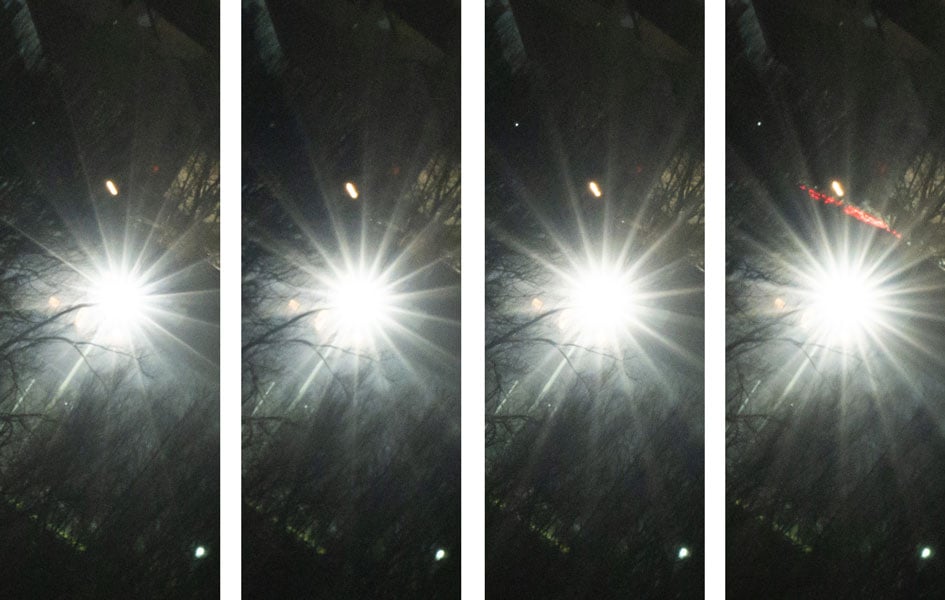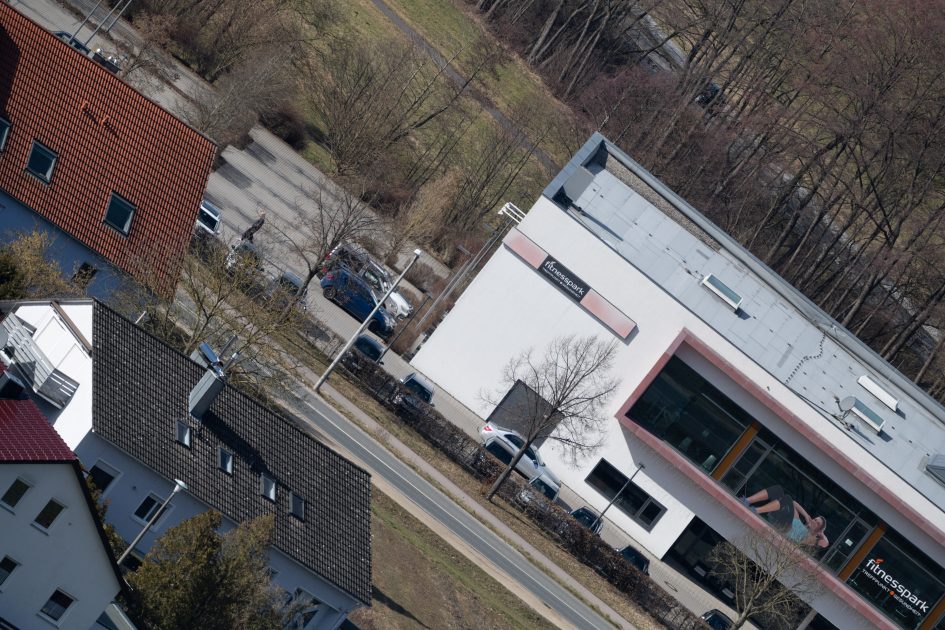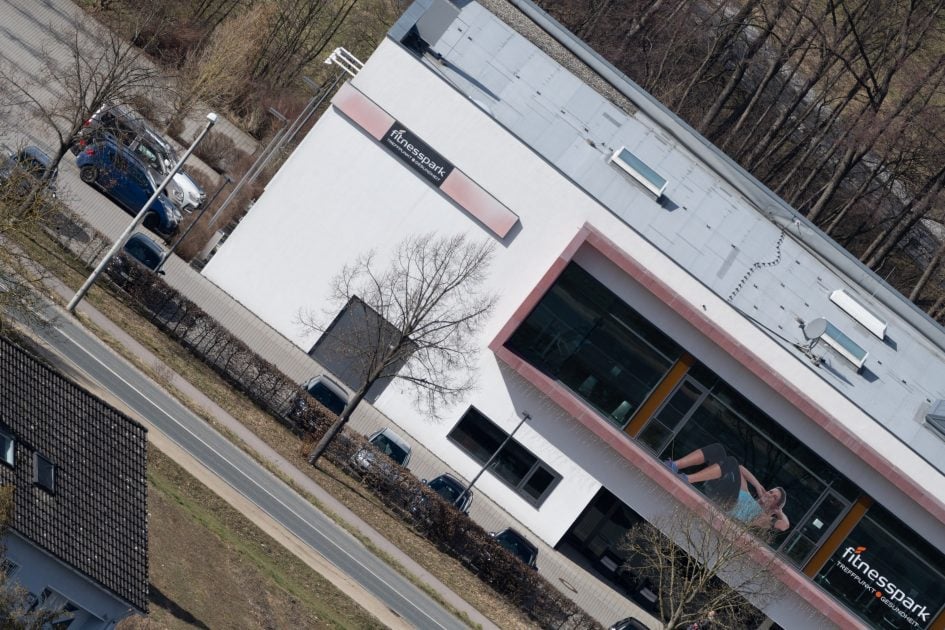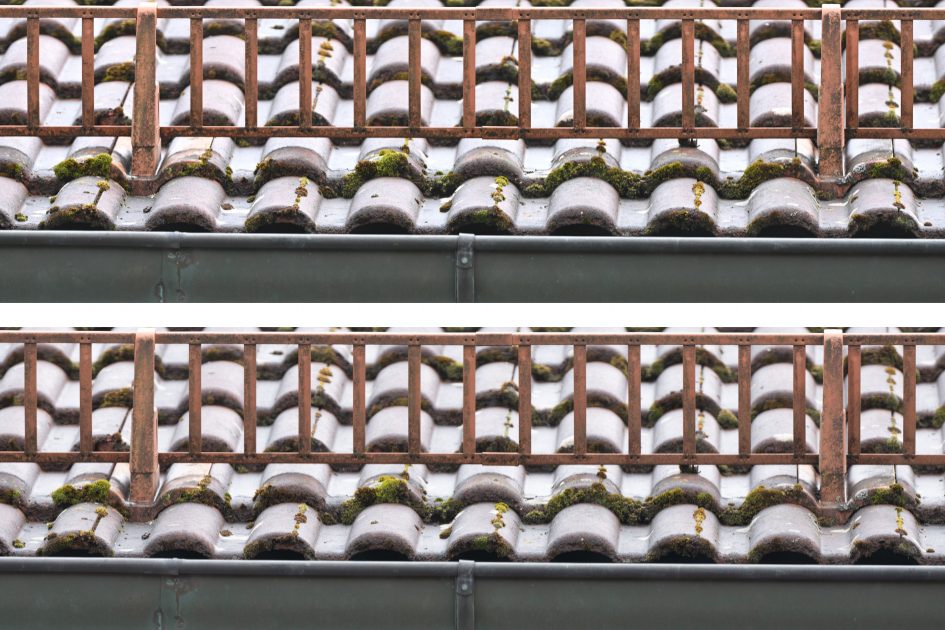Nikon Z 400mm f2.8 TC VR S review
-
-
Written by Thomas
Quality
Longitudinal Chromatic Aberration and focus shift
With large aperture lenses longitudinal color aberrations (loCA, a.k.a. “axial color” or “bokeh CA”) can be a problem. These show up as magenta coloration in the foreground and greenish hues in the background and are not easily corrected in post-processing. But in my tests the new Z-Nikkor showed no discernible loCA. Regarding focus shift: When stopped down the background becomes sharper faster than the foreground but this is not a problem at 400mm focal length.
Nikon Z 400mm f2.8 TC VR S longitudinal Chromatic Aberration (loCA)

Above from top to bottom: 400mm f2.8, f4.0, f5.6; 100% crops, left = foreground, right = background
At 560mm focal length the shift towards the background when stopping down from f4.0 to f5.6 is a tad stronger and can lead to subjects close to the focal plane become just a tiny bit softer – if you don’t refocus at f5.6.
In all of my test-shots with the Nikon Z 400mm f2.8 TC VR S I could not detect any purple fringing around high-contrast edges in the focus plane and no green outlining around background subjects. Very good!
Sharpness and contrast
Let’s have a look at the theoretical performance of the Nikon Z 400mm f2.8 TC VR S and compare it to its predecessor and the Nikon Z 100-400mm f4.5-5.6 VR S:

Above: Nikon Z 400mm f2.8 TC VR S at 400mm f2.8 (left), 560mm f4.0 (right)

Above: Nikon AF-S 400mm f2.8E FL ED VR at 400mm f2.8 Left), plus TC-1.4EIII at 560mm f4.0 (right)

Above: Nikon Z 100-400mm f4.5-5.6 VR S at 100mm f4.5 (left), 400mm f5.6 (right)
These MTF charts show the computed lens-performance of lenses wide open at infinity without influence of diffraction at 10 line-pairs/mm (red) and 30 lp/mm (blue). Higher values are better (more contrast) and the closer the dotted and solid lines are together the less contrast dependents on the orientation of the test-pattern (less astigmatism). The x-axis displays the distance from the optical axis (=center of the sensor) in mm. I’ll show you real-life performance at 4 mm (“center”), 13 mm (APS-C/DX-corner), and 20 mm (FF/FX-corner) on a on a 45MP Nikon Z7 camera.
From the charts both 400mm f2.8 lenses show extremely high overall contrast even when used with a 1.4x teleconverter. But looking closely at the resolution of finer details the new Z 400mm f2.8 TC VR S seems to show a little less contrast than its predecessor. The Nikon Z 100-400mm f4.5-5.6 VR S does not look too bad in this comparison at 400mm. But keep in mind that it is shown here at f5.6.
Let’s see how this theoretical performance translates into real life results in the sharpness test based on Siemens-stars shot on a 45MP Nikon Z7. Processing was done in Lightroom 11.2/CRAW 14.2 from RAW to Adobe Color profile with the built-in lens profile for CA, vignette control and distortion compensation applied. Noise-reduction is set to 0, sharpening to 50/0.5/36/10, with no extra tone, color, or saturation adjustment. White-balance was adjusted to a neutral white and I did some exposure compensation to make the brightness of all crops match. So you will not see light fall-off in the corners.
The following are all 100% crops!
First up is an overview of the wide-open performance at different focal lengths – including 800mm and 1120mm shot with the Nikon Z TC-2.0x. You can jump to the detailed results at different apertures and comparisons with the Nikon Z 100-400m f4.5-5.6 VR S by clicking on the crops of the respective focal length.
Nikon Z 400mm f2.8 TC VR S; 100% crop from center, DX-corner, FX-corner
Above: 400mm, f2.8
Above: 560mm, f4.0
Above: 800mm, f5.6 (with Z TC-2.0x)
Above: 1120mm, f8.0 (with Z TC-2.0x)
Even wide open Nikon’s Z 400 TC looks extremely sharp across the full-frame sensor at 400mm with only a slight softening towards the FX-corner starting at around 16mm image height. Switching on the internal 1.4x teleconverter robs surprisingly little acuity with the FX-corner looking even a tad sharper than without TC. This results in very even sharpness across the frame. Mounting the Z TC-2.0x and switching off the built-in TC (800mm focal length) still delivers very good performance up to 9mm image height, comparable to the results at 560mm – in the inner image-circle up to 4mm height even slightly better. And while the DX-corner visibly softens up and the FX-corner becomes pretty mushy I’d still consider Nikon’s Z 400mm f2.8 TC VR S and their Z TC-2.0x a very good match. But using both the internal TC and the Z TC-2.0x to reach 1120mm focal length is overtaxing the lens’s abilities: even the center becomes soft and I’d rather suggest to use a DX-crop shot at 800mm f5.6 than the full-frame at 1120mm f8.0. Stopping down to f11 helps a bit as you can see below but then you loose two stops of light-gathering power over the 800mm f5.6 shot.
Field curvature is almost a non-issue with the lens. Only if you use the external TC it affects the outer areas. So it’s probably of little relevance for most shooting situations!
The following 100% crops for each focal length show the Nikon Z 400mm f2.8 TC VR S from wide open down to f8/f11 compared to the Nikon Z 100-400mm f4.5-5.6 VR S + Z TC-1.4x up to 560mm.The zoom lens was shot in JPG normal with standard picture control which applies a stronger sharpening. It’s not my preferred settings but it will have to do for this comparison.
If you want to see all the details and comparisons read on. Or you can fast-forward to the performance at long distances.
Performance at 400mm:
Nikon Z 400mm f2.8 TC VR S at 400mm compared; 100% crop from center, DX-corner, FX-corner

Above: Nikon Z 400mm f2.8 TC VR S at 400mm, f2.8

Above: Nikon Z 400mm f2.8 TC VR S at 400mm, f4.0

Above: Nikon Z 400mm f2.8 TC VR S at 400mm, f5.6

Above: Nikon Z 100-400mm f4.5-5.6 VR S at 400mm, f5.6

Above: Nikon Z 400mm f2.8 TC VR S at 400mm, f8.0
No need to stop down the Nikon Z 400mm f2.8 TC VR S at 400mm. Only the FX-corner profits visibly from stopping down to f4 or f5.6.
Performance at 560mm:
Nikon Z 400mm f2.8 TC VR S at 560mm compared; 100% crop from center, DX-corner, FX-corner

Above: Nikon Z 400mm f2.8 TC VR S at 560mm, f4.0

Above: Nikon Z 400mm f2.8 TC VR S at 560mm, f5.6

Above: Nikon Z 400mm f2.8 TC VR S at 560mm, f8.0

Above: Nikon Z 100-400mm f4.5-5.6 VR S + Z TC-1.4x at 560mm, f8.0
Same story as at 400mm focal length although the FX-corner does not profit as much from stopping down.
Performance at 800mm:
Nikon Z 400mm f2.8 TC VR S + Z TC-2.0x at 800mm; 100% crop from center, DX-corner, FX-corner

Above: Nikon Z 400mm f2.8 TC VR S + Z TC-2.0x at 800mm, f5.6

Above: Nikon Z 400mm f2.8 TC VR S + Z TC-2.0x at 800mm, f8.0

Above: Nikon Z 400mm f2.8 TC VR S + Z TC-2.0x at 800mm, f11
Stop down to f8.0 to give the DX-corner a slight lift, but the FX-corner only sharpens up at f11. But then diffraction is already setting in.
Performance at 1120mm:
Nikon Z 400mm f2.8 TC VR S + Z TC-2.0x at 1120mm; 100% crop from center, DX-corner, FX-corner

Above: Nikon Z 400mm f2.8 TC VR S + Z TC-2.0x at 1120mm, f8.0

Above: Nikon Z 400mm f2.8 TC VR S + Z TC-2.0x at 1120mm, f11
At 1120mm the combo of Nikon Z 400mm f2.8 TC VR S plus Z TC-2.0x profits visibly from stopping down to f11. But still: Using a DX-crop on a 800mm shots looks like the better alternative.
All-in-all the Nikon Z 400mm f2.8 TC VR S zoom lens is extremely sharp when used at 400mm focal length even wide open at f2.8. Evidence to its superior performance are the very good results when used with the built-in 1.4x TC or in combination with a Z TC-2.0x as any fault of the lens is magnified by 1.4x or 2x. Only using both teleconverters at the same time shows the limits of this lens.
Performance at long distances
The Siemens-star test-targets are shot at a distance of 45x focal length (i.e. at around 25m for 560mm focal length). But performance of lenses also depends on the shooting distance. Therefore I present another series of images shot on a 45MP Nikon Z 7 of a city around 1 km away. Processing was done in Lightroom 11.2/CRAW 14.2 from RAW to Adobe Color profile with the built-in lens profile compensating CA, vignetting, and distortions. Noise-reduction is set to 0, sharpening to 50/0.5/36/10, with no extra tone, color, or saturation adjustment. All shots were made from a heavy tripod with image stabilization switched off and I used ISO 250 for 400mm and 560mm focal length and ISO 800 for 800mm and 1120mm focal length to reduce shutter speeds as the wind was pretty strong at the time. As the Z 400 TC was only minimally decentered there was no need to selected the diagonal that provided the better corner results.
The following images show the complete scene wide open plus 100% crops roughly from the center, DX-corner, and FX-corner. You can access the large originals but these files are for personal evaluation only and cannot be used in another publication or website without permission..
Nikon Z 400mm f2.8 TC VR S
Above: Nikon Z 400mm f2.8 TC VR S at 400mm, f2.8; click image for 4k version, here for large original; crops also available at f4.0, f5.6, f8.0
Above: Nikon Z 400mm f2.8 TC VR S at 560mm, f4.0; click image for 4k version, here for large original; crops also available at f5.6, f8.0
Above: Nikon Z 400mm f2.8 TC VR S + Z TC-2.0x at 800mm, f5.6; click image for 4k version, here for large original; crops also available at f8.0
Above: Nikon Z 400mm f2.8 TC VR S + Z TC-2.0x at 1120mm, f8.0; click image for 4k version, here for large original crops also available at f11
The Nikon Z 400mm f2.8 TC VR S again shows its merits in this long-distance test producing very sharp images wide open – at 400mm even right into the FX-corner. But apart from the softer FX-corner at 560mm and 800mm the lens can confidently be used with the built-in 1.4x TC or the external Z TC-2.0x and get really sharp results. But (again) stacking both TCs to achieve 2.8x magnification is not the best idea: better use a DX-crop on an 800mm shot.
Vignetting and distortions
To make it easier to see light fall-off in the corners of a full-frame sensor I’ve arranged a series of three shots each with the Nikon Z 400mm f2.8 TC VR S both with and without the built-in teleconverter. All images were developed to the same brightness in the center and are shown with vignette control Off (1st row) resp. Normal (2nd row):

Above: Nikon Z 400mm f2.8 TC VR S at 400mm

Above: Nikon Z 400mm f2.8 TC VR S at 560mm
Wide open vignetting is relatively mild with the lens profile applied and practically irrelevant once the aperture is closed one stop. With vignette control set to normal the extreme corners are lifted about 0.6 EV when the aperture is wide open. Adobe’s RAW converter automatically applies vignette control as it was set in camera – but you cannot alter the setting in postprocessing.
Distortions are almost non-existent. The setting for distortion compensation in camera is currently ignored by Adobe’s RAW converter and treated as ON. The following composite images show a roof rail at the upper border of the full-frame image first without distortion compensation (JPG) and then with compensation from the built-in lens profile applied to RAW:
Distortions: Nikon Z 400mm f2.8 TC VR S at 400mm, auto distortion control Off (top), On (bottom)
Rendering of point-light sources at night-shots
Night-shots pose a different challenge for lenses as the contrast is even higher than under bright sun and point-light sources can reveal some weaknesses such as coma, haloing and colour-aberrations that do not show up as prominently in other test-shots. The 100% crops below the main image show the effect of coma in the FF-corner of the Nikon Z 400mm f2.8 TC VR S at different apertures:
Above: Nikon Z 400mm f2.8 TC VR S f2.8; click image for 4k version, here for large original

Above: Nikon Z 400mm f2.8 TC VR S; 100% crops from the FX-corner at f2.8 (left), f4.0 (middle), f5.6 (right)
The Nikon Z 400mm f2.8 TC VR S produces very little coma even wide open. The test also shows no color artifacts around bright streetlights.
Bokeh quality
This test is for the rendering of point-light sources in an out-of-focus background. The circle of confusion that is produced by the test is pretty indicative of Bokeh performance (in the background) and light fall-off. Ideally the out-of-focus image of the point-light is evenly lit and perfectly circular, with no “onion-rings”, and without coloration. Large aperture lenses normally produce an effect known as “cat’s eye” the further away from the optical axis the point-light is projected. This is due to optical vignetting in the lens barrel when light enters the lens from an angle.
Above: Nikon Z 400mm f2.8 TC VR S at 400mm, f2.8; 4k versions available at f2.8, f4.0, f5.6, f8.0
The diameter of the Bokeh balls in the center is determined by the entrance pupil of the lens which is a huge 143mm. Compression of the circle towards the corners is relatively strong wide open. The circle of confusion in the center is no longer perfectly circular from f4.0 onwards – which is the reason you can produce diffraction spikes with this lens already at f4.0. The inside of the Bokeh balls is smoothly textured but there is a bit of outlining – albeit without coloration from loCA.
Switching on the built-in teleconverter does not change the entrance pupil of the lens and normally you’d expect the Bokeh balls to be of the same size – provided magnification is identical. But as I did not change the focus distance in the following shots magnification was increased 1.4x and so was the diameter of the Bokeh balls.
Above: Nikon Z 400mm f2.8 TC VR S at 560mm, f4.0; 4k versions available at f4.0, f5.6, f8.0
Head over to my page with sample images which were shot mostly wide open to get a better impression of how Bokeh of the lens looks in different situations. I personally find it smooth in the transition zone and background although double contours can raise their ugly head e. g. when a wire-mesh fence is relatively closely behind your subject.
Close-up performance
The Nikon Z 400mm f2.8 TC VR S achieves a maximum magnification of around 1:6 without teleconverter and 1:4 with teleconverter in close-up shooting. The crops shown below are from 0mm, 12mm, and 19mm off the center of the sensor respectively, the area of sharp focus is 142 x 212mm.
Nikon Z 400mm f2.8 TC VR S at 400mm, 1:5.9 magnification; 100% crops

Above: Nikon Z 400mm f2.8 TC VR S at 400mm, f2.8

Above: Nikon Z 400mm f2.8 TC VR S at 400mm, f5.6

Above: Nikon Z 400mm f2.8 TC VR S at 400mm, f11
At 400mm focal length close-up performance is pretty good – even wide open. Stop down to f5.6 and performance is very good even into the corners. Field curvature is very low, in this test all crops are from the same shot. I repeated the test at 560mm focal length. The crops are from 0mm, 11mm, 19mm image height, the area of sharp focus is 98 x 148mm. Results are a bit softer than at 400mm but stopping down to f5.6 helps.
Nikon Z 400mm f2.8 TC VR S at 560mm, 1:4.1 magnification; 100% crops

Above: Nikon Z 400mm f2.8 TC VR S at 560mm, f4.0

Above: Nikon Z 400mm f2.8 TC VR S at 560mm, f5.6

Above: Nikon Z 400mm f2.8 TC VR S at 560mm, f11
Sun-stars
The lens produces sunstars already at f4.0 – but they are nicest at f8.0. See below:

Above: Sunstars from the Nikon Z 400mm f2.8 TC VR S at 400mm, f4.0, f5.6, f8.0, f11 (from left to right), 50% crops
Next check out my sample images!
Check prices on the Nikon Z 400mm f2.8 at B&H, Adorama, WEX UK or Calumet.de. Alternatively get yourself a copy of my In Camera book or treat me to a coffee! Thanks!















